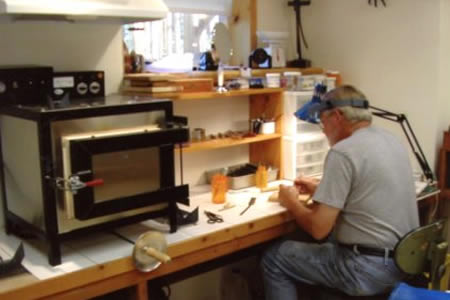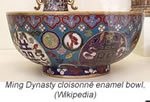Home | The Artist | Crosses | Paintings | Graphic Art | Sculptures | Liturgical Art | Jewelry
510 West Hills Way NW • Salem, Oregon 97304 • (503)949-6641 cell • Contact Us
©2014 JoelNickelArt • All Rights Reserved.



Enamel is glass, fused to metal (usually copper). It is applied to the metal in a finely sifted powdered form, wet-packed onto the metal “sandwich”. The copper gives the piece strength while the enamel gives the piece color. Each piece goes through a number of different stages of firing in a kiln (about 3 minutes at 1500 degrees). Counter enamel is fused to the back side, a thin base coat of transparent enamel is fused to the top side. “Cloisonnes” (sections of pure silver wire) are tacked onto the base coat and fired in the kiln. The wire serves to separate the different colors. A number of successive firings are needed to establish color control. The surface is “stoned” to make it smooth and the piece is then fired again. Edges are cleaned up with a diamond file. It is a labor intensive process.
Sometimes the color choices reflect the seasons of the church year cycle, sometimes the colors reflect emotional stress and energy. Opaque and transparent colors used side by side offer the contrast of depth; transparent colors over silver or gold foil create rich colors.
These pectoral crosses were produced back in 2001 and are considered "early Cloisonne enamel crosses."
Works that are neither pectoral crosses or jewelry
The [Cloisonne] technique was in ancient times mostly used for jewellery and small fittings for clothes, weapons or similar small objects decorated with geometric or schematic designs, with thick cloison walls. In the Byzantine Empire techniques using thinner wires were developed to allow more pictorial images to be produced, mostly used for religious images and jewellery, and by then always using enamel. By the 14th century this enamel technique had spread to China, where it was soon  used for much larger vessels such as bowls and vases; the technique remains common in China to the present day, and cloisonné enamel objects using Chinese-derived styles were produced in the West from the 18th century. (Wilipedia)
used for much larger vessels such as bowls and vases; the technique remains common in China to the present day, and cloisonné enamel objects using Chinese-derived styles were produced in the West from the 18th century. (Wilipedia)